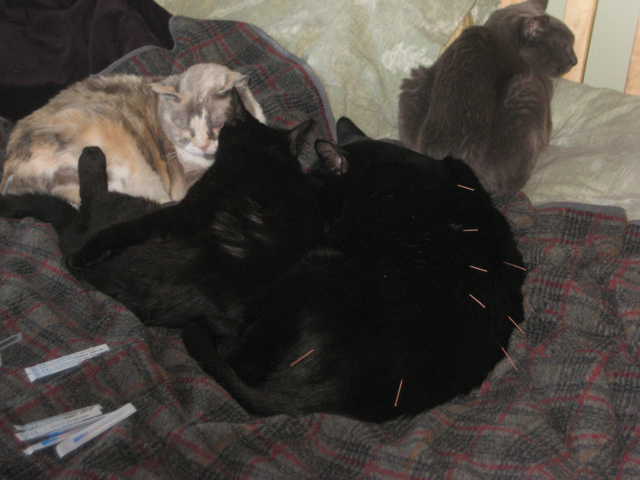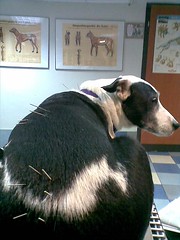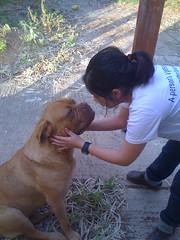 Sometimes I get so caught up in my little world of very well treated dogs that I tend to forget about all the ones out there suffering. In the Seattle area we are being given an opportunity to make a difference for those who don’t have the wonderful lives of the animals I know.
Sometimes I get so caught up in my little world of very well treated dogs that I tend to forget about all the ones out there suffering. In the Seattle area we are being given an opportunity to make a difference for those who don’t have the wonderful lives of the animals I know.
Thank you Margo for bringing this to my attention!
King County is considering an ordinance which would make it illegal to leave your dog chained outside continually. Here is a detailed article from the Seattle P-I, Law would prohibit pet owners from continuously confining dogs. Right now there is nothing within the law to help these poor animals which are left on the end of a chain for their whole lives being denied the love and family they long for. Not only is this a sad and horrible life for these dogs but chained dogs tend to have more issues with aggression and are more likely to bite and harm children and other people. In fact there is a group called Mothers against dog chaining dedicated to this issue.
 Here is a wonderful explanation by Cesar Milan on why dogs should not be tethered.
Here is a wonderful explanation by Cesar Milan on why dogs should not be tethered.
If you are in the King County area please take a moment to contact your council member. For a list of the names and contact information of these folks, please visit The King County Council Directory. If you are not in the Seattle area consider contacting your local council folk to see if they will address this issue in your area.
Here is a copy of the letter Margo wrote addressing some of the horrible situations she has seen in her work with animals.
Dear Councilmember,
First, I would like to thank you for taking the time to consider this
important issue.
Chaining a dog as a way of life is both cruel to the animal and dangerous to
humans, especially children. The dog most likely to attack and seriously
injure or kill a child is a chained, un-neutered male. For more on this,
please go to Mothers against dog chaining .
As someone who has observed and tried to help a number of chained dogs over
the years, I can say I have yet to see a chained dog that has adequate food,
water, shelter or a remotely clean living area, let alone socialization,
exercise or vet care. Many dogs suffer profound neck injuries and even death
when embedded chains finally sever their windpipe. Most people seem to think
their dogs are somehow weatherproof as well.
Just a few examples of what I’ve seen personally:
A young boxer who was chained because the owner said she jumped on his two
year old son. Inadequate food, water, shelter and feces everywhere. She was
kept out in sub-freezing weather, and you could see her visibly shivering.
A pitbull chained to a tree with no food, no water and no shelter. The chain
was so heavy she could only move her eyes.
Two pitbulls at another house, one chained to the front step, and another
chained to a doghouse in the backyard. There was so much mud, the dog
refused to leave the doghouse. Both were on extremely heavy chains.
A husky-cattle dog who was chained to a tree, and wrapped himself up so
tight he couldn’t move. The owner said “Yeah, he does that”. Dirty water, no
food, and he couldn’t even get to his doghouse.
The German Shepherd whose owner would walk out the back porch and throw raw
hamburger into the dirt. The police ended up shooting and killing the dog.
The Saint Bernard who simply laid on his side in the dirt, never moving, the
picture of utter hopelessness and defeat.
The people in the P-I article never cease to amaze me, either.
The woman in Snoqualmie who got herself a young, high energy spaniel-lab,
which she sentenced to living on a chain because “he’s hyperactive”.
The couple in Maple Valley whose yellow lab is chained because “he’s not
housebroken and he sheds”.
The dog in Rainier Valley who is occasionally fed rice and has been chained
the last five years.
The fourteen year old husky mix who has probably been chained to that fence
in Enumclaw his entire life. His crime? “He runs away”.
All these people have abdicated their responsibility to exercise and train
their animals. It is simply easier to chain them and forget about them,
while blaming the animal for the problem the human has created.
The man and his son in Maple Valley who are training attack dogs. The photo
showed a young pitbull in a plywood shack of a doghouse. They did have
enough money to crop the dog’s ears, however.
The breeders and others who will yell and scream at you that it’s their
right to chain their dogs are merely keeping them as cheaply as possible
until they sell them and make a quick buck. They are no better than puppy
millers in the sense that they don’t care one iota about the well being of
the dogs, nor do they consider the possible damage the animal could do
if/when the dog becomes aggressive due to being kept chained and
unsocialized.
I hope you will pass a real anti-chaining ordinance that has, pardon the
pun, teeth.
Sincerely,
Margo W.
West Seattle









 My husband and I both at the exact same time, in the exact same way said “We’ll take him!” without even ever seeing him! The lady was relieved that we didn’t care about his little missing foot. So we went into the back where they took him out and let us play with him.
My husband and I both at the exact same time, in the exact same way said “We’ll take him!” without even ever seeing him! The lady was relieved that we didn’t care about his little missing foot. So we went into the back where they took him out and let us play with him.




